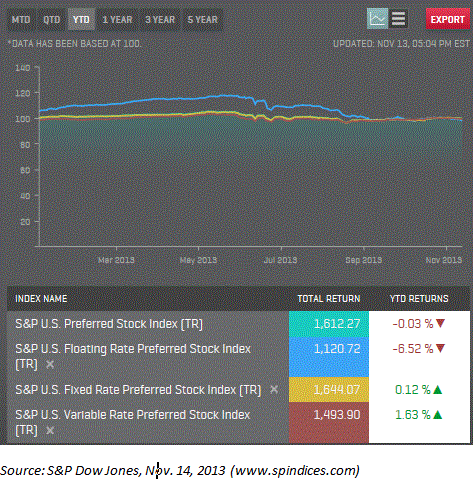Preferred indices started the year with some very strong returns. First quarter 2013 saw the S&P U.S. Preferred Stock Index (TR) return 3.13%. By the end of April, the overall index was up 4.40% year-to-date while the floating rate component of the index, as measured by the S&P U.S. Floating Rate Preferred Stock Index (TR), was returning 10%. The reason a higher return is not reflected in the overall index is that floating rates only make up 4% of the index.
The summer months took their toll on the preferred indices as May returns for fixed (-0.57%) and variable (-1.69%) coupon preferreds sold off while floaters held on, returning just under 1% for the month. June was the month that delivered the damaging blow, as the markets became very concerned after the FOMC meeting hinted at the tapering of Fed stimulus. The yield-to-worst on the S&P/BGCantor Current 10 Year U.S. Treasury Bond Index rose 33 basis points throughout the month, from 2.12% to 2.47%, with the majority of the increase occurring after the June 19 FOMC announcement. The index was down 2.20% for the month as floaters dropped 5.91%, fixed coupons were down -2.16%, and variable coupons, as measured by the S&P U.S. Variable Rate Preferred Stock Index (TR), were down 1.04%.
Returns for July and August were not any better, and it was not until September that preferred returns began to recover. Though the overall index returned 0.26% for the month, the positive performance resulted from both fixed-rate and variable-rate coupons, while floaters remained in the red returning -1.57% for the month. October was the first month in which fixed-, variable-, and floating-rate coupons all had positive returns. The kicking of the can down the road on the U.S. debt ceiling and a stronger message from the Fed that stimulus will continue for the near future led to renewed confidence, not only in preferreds, but in all fixed income markets.
With November only half over, returns on the preferred indices are down (as seen in the table below). Rates, as measured by the S&P/BGCantor Current 10 Year U.S. Treasury Bond Index, have resumed their upward movement, going from a yield-to-worst of 2.55% at the beginning of the month to its present 2.73%. Markets are somewhat confident that the Fed will continue its stimulus, but other factors such as the pace of economic recovery, as measured by numerous economic indicators, will continue to determine the rest of the month’s performance.
For additional index information, please refer to www.spindices.com


The posts on this blog are opinions, not advice. Please read our Disclaimers.













































